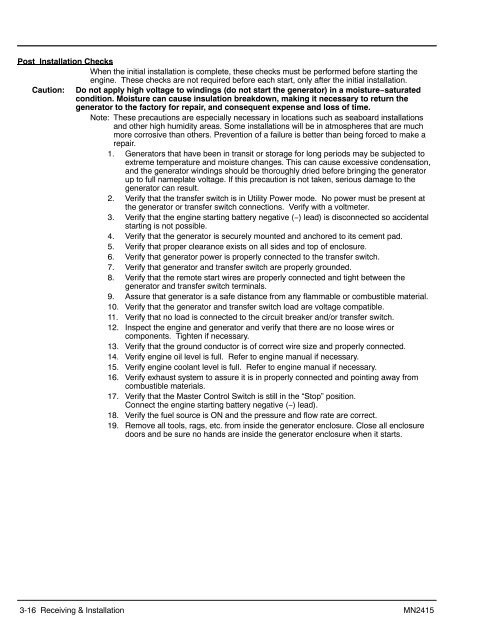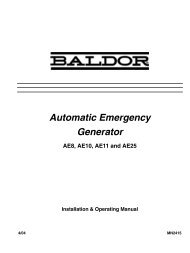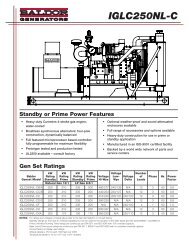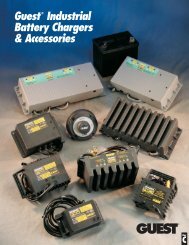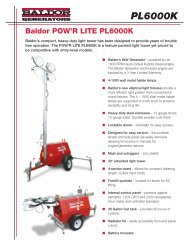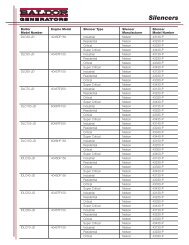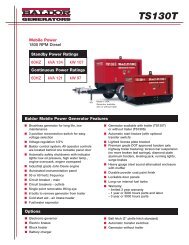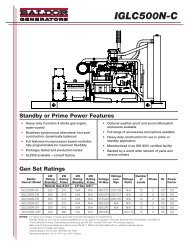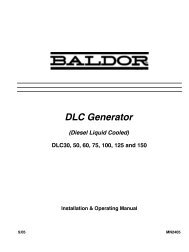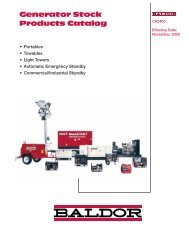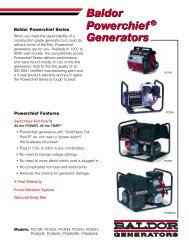Installation & Operation Manual - Phase-A-Matic, Inc.
Installation & Operation Manual - Phase-A-Matic, Inc.
Installation & Operation Manual - Phase-A-Matic, Inc.
You also want an ePaper? Increase the reach of your titles
YUMPU automatically turns print PDFs into web optimized ePapers that Google loves.
Post <strong>Installation</strong> Checks<br />
When the initial installation is complete, these checks must be performed before starting the<br />
engine. These checks are not required before each start, only after the initial installation.<br />
Caution: Do not apply high voltage to windings (do not start the generator) in a moisture−saturated<br />
condition. Moisture can cause insulation breakdown, making it necessary to return the<br />
generator to the factory for repair, and consequent expense and loss of time.<br />
Note: These precautions are especially necessary in locations such as seaboard installations<br />
and other high humidity areas. Some installations will be in atmospheres that are much<br />
more corrosive than others. Prevention of a failure is better than being forced to make a<br />
repair.<br />
1. Generators that have been in transit or storage for long periods may be subjected to<br />
extreme temperature and moisture changes. This can cause excessive condensation,<br />
and the generator windings should be thoroughly dried before bringing the generator<br />
up to full nameplate voltage. If this precaution is not taken, serious damage to the<br />
generator can result.<br />
2. Verify that the transfer switch is in Utility Power mode. No power must be present at<br />
the generator or transfer switch connections. Verify with a voltmeter.<br />
3. Verify that the engine starting battery negative (−) lead) is disconnected so accidental<br />
starting is not possible.<br />
4. Verify that the generator is securely mounted and anchored to its cement pad.<br />
5. Verify that proper clearance exists on all sides and top of enclosure.<br />
6. Verify that generator power is properly connected to the transfer switch.<br />
7. Verify that generator and transfer switch are properly grounded.<br />
8. Verify that the remote start wires are properly connected and tight between the<br />
generator and transfer switch terminals.<br />
9. Assure that generator is a safe distance from any flammable or combustible material.<br />
10. Verify that the generator and transfer switch load are voltage compatible.<br />
11. Verify that no load is connected to the circuit breaker and/or transfer switch.<br />
12. Inspect the engine and generator and verify that there are no loose wires or<br />
components. Tighten if necessary.<br />
13. Verify that the ground conductor is of correct wire size and properly connected.<br />
14. Verify engine oil level is full. Refer to engine manual if necessary.<br />
15. Verify engine coolant level is full. Refer to engine manual if necessary.<br />
16. Verify exhaust system to assure it is in properly connected and pointing away from<br />
combustible materials.<br />
17. Verify that the Master Control Switch is still in the “Stop” position.<br />
Connect the engine starting battery negative (−) lead).<br />
18. Verify the fuel source is ON and the pressure and flow rate are correct.<br />
19. Remove all tools, rags, etc. from inside the generator enclosure. Close all enclosure<br />
doors and be sure no hands are inside the generator enclosure when it starts.<br />
3-16 Receiving & <strong>Installation</strong> MN2415


